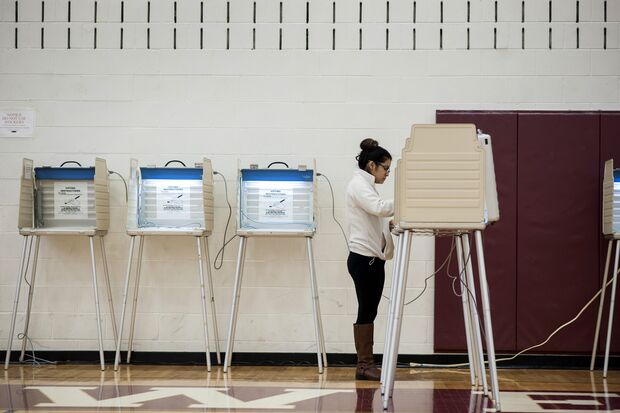How U.S. Picks Its President, Iowa Caucuses to Nov. 3: QuickTake
Bloomberg Government subscribers get the stories like this first. Act now and gain unlimited access to everything you need to know. Learn more.

Photographer: Sean Proctor/Bloomberg
The Situation
American voters nominate two major-party candidates for president, then decide on a winner, through a grueling process that can last two years (or longer) and expend billions of dollars. To become the nominee of the Republican or Democratic party, a candidate must first survive a long series of state-level primaries (statewide votes by secret ballot) and caucuses (public meetings where voters choose candidates by a show of hands or by gathering in groups). Small rural states, notably Iowa and New Hampshire, wield and jealously guard extra influence by holding the earliest of those contests. Candidates spend months meeting the states’ voters in school gyms, diners and living rooms, all in hopes of winning delegates who, at Democratic and Republican conventions, translate the primary and caucus votes into formal nods for their party’s presidential nominee. An early lead locking down delegates can build momentum for a candidacy. The general election, which takes place on the first Tuesday following the first Monday in November, is officially decided not by who wins the most popular votes but via a quirky mechanism called the Electoral College.
The Background
The framers of the Constitution might be surprised how presidents are chosen these days. Political parties, for instance, weren’t involved until Congress gave in to popular demand and amended the Constitution in 1804 to require separate Electoral College votes for president and vice president, opening the door to what today are presidential tickets. (Until then, there was one vote, with the runner-up becoming vice president.) Despite occasional bids by third-party candidates, all presidents have been members of the Republican or Democratic parties ever since Millard Fillmore, a member of the Whig Party, left office in 1853. The two parties now oversee the nominating process. The contenders who emerge from that compete in a general election determined by a body, the Electoral College, that also reflects compromises of centuries ago. It was created by the nation’s founders as a middle ground between those who favored a direct popular vote and those who wanted lawmakers to pick the president. When an American casts a vote for president, he or she is technically voting for a slate of individuals known as electors who have pledged to support that candidate. A few weeks after a presidential election, electors meet in their state capitals to cast their votes. This generally means rubber-stamping the result of the popular vote in their state, though on rare occasions an elector breaks that tradition. The candidate who secures a simple majority, or 270 of the total 538 electors, wins the presidency. Every state is assigned as many electors as it has members of Congress — three to 55, depending on population. The guaranteed minimum of three electors amplifies the relevance of the least populous states, such as Wyoming and Vermont.
The Argument
It’s hard to deny that in presidential elections, some voters matter more than others. A resident of New Hampshire may have face-to-face interactions with multiple presidential hopefuls during the run-up to that state’s influential early primary, while traditional late-deciding states such New Jersey are at risk of irrelevance should a candidate sew up the nomination by the time they vote. Critics of the system say that because rural states kick off the nomination process, urban issues get short shrift; defenders say that small states and farm areas would otherwise be overlooked. A similar dynamic skews the general election campaign. The electoral votes of many states are taken for granted because they are reliably Democratic (such as California) or Republican (Texas), while “swing states” — those seen as up for grabs — are lavished with campaign money and candidate attention. A narrow win in a swing state is a huge prize because most states, since the early 19th century, have awarded all, rather than a proportionate amount, of their electors to the winner of the popular vote. Republican Donald Trump won the 2016 presidential election in part by prevailing narrowly in swing states North Carolina and Florida even as Democrat Hillary Clinton was collecting the most votes nationwide. Losers of the popular vote became president in 1876, 1888 and 2000, as well. After each such election, there’s a predictable push from the losing side to make the popular vote decisive, but many states, especially small ones, are unwilling to switch, citing the loss of sway.


The Reference Shelf
- Alexander Hamilton wrote in a 1788 letter that the Electoral College would make sure candidates with “talents for low intrigue, and the little arts of popularity” could be rejected in favor of “characters preeminent for ability and virtue.”
- It’s time to abolish the Electoral College, says this paper by Darrell M. West from the Brookings Institution.
- Due to the winner-take-all system, just 78,000 popular votes effectively decided the 2016 presidential election.
- A Pew Research Center report, “Contested presidential conventions, and why parties try to avoid them.”
- The National Conference of State Legislatures summarizes the movement to let the national popular vote decide the presidency.
(A previous version of this story had an incorrect date in the headline.)
Stay informed with more news like this – from the largest team of reporters on Capitol Hill – subscribe to Bloomberg Government today. Learn more.